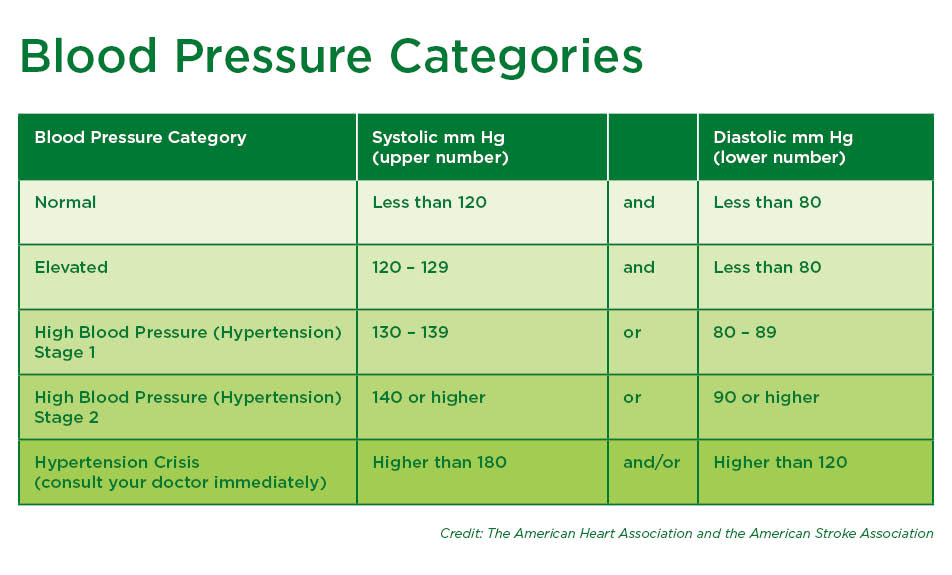
McKenna Gottfried, BSN, RN, Well-Being Nurse Navigator, Parkview Center for Healthy Living, shares the importance of getting screenings done regularly to maintain and improve your overall health.
Although your path to enhanced health and well-being is unique, everyone shares the same starting point: knowing your numbers. These include:
- Blood pressure
- Cholesterol
- Blood sugar
- Body mass index (BMI)
- Waist circumference
These numbers tell an important story about your overall health. Perhaps you’re at-risk for developing type 2 diabetes or heart disease, or maybe you’re perfectly healthy. Knowing your numbers, and understanding what they mean, will help you take action toward leading a longer, healthier, happier life.
Blood Pressure
Blood pressure measures the amount of force it takes your heart to pump blood through your body. It is measured as two numbers:
- Systolic pressure is the first number. It’s the pressure when your heart contracts (or squeezes).
- Diastolic pressure is the second number, and it’s the pressure when your heart is resting between beats.
Blood pressure is one of the strongest markers for your risk of heart disease. The higher each reading is, the greater your chance of heart disease, heart attack, stroke and diabetes. Hypertension (high blood pressure) can also damage your brain, eyes and arteries.

To improve your blood pressure:
- If you carry excess weight, reduce it through proper nutrition, physical activity and behavioral therapy – the help of a health coach can make a big difference throughout your journey.
- Maintain at least 30 minutes of aerobic activity most days of the week. Brisk walking is a great start.
- Consider following the dietary approaches to stop hypertension (DASH) diet. This heart-healthy, balanced diet emphasizes vegetables, fruits, whole grains, low-fat dairy products, legumes, nuts, fish, poultry and lean meats.
- Limit your intake of sodium (salt). Shoot for less than 2.4 grams or 2,400 mg per day.
- Limit your intake of alcohol. This means no more than one glass per day for women and no more than two glasses per day for men.
Cholesterol
A “sudden” heart attack may not be sudden at all, but may be caused by years of living with high cholesterol, extra lipids (fats) your body stores and high triglycerides. High cholesterol and extra lipids clog your arteries and can cause heart attacks and stroke. Elevated triglycerides also increase your risk for chronic diseases.
Your total cholesterol is measured by:
- High density lipoprotein (HDL) ? good cholesterol
- Low density lipoprotein (LDL) ? lousy cholesterol
- 20 percent of your triglycerides
The higher your HDL, and the lower your LDL, the more protected you are from heart disease and heart attack.
HDL Levels
Desirable: 60 mg/dL (or higher)
Borderline low: 40 – 60 mg/dL
At-risk for disease: 40 mg/dL (or lower)
LDL Levels
Desirable: 100 mg/dL (or lower)
Borderline high: 130 – 159 mg/DL
At-risk for disease: 160 mg/dL (or higher)
Triglycerides Levels
Desirable: Less than 150
Borderline high: 150 – 199
At-risk for disease: 200 or higher
To improve your cholesterol:
- Limit your intake of red meat and fatty animal products like full-fat dairy milk, cream, ice cream, butter and cheese. Instead, choose lean cuts of meat like fish, skinless chicken and 1%, fat-free or skim milk.
- Avoid fried and baked food items made with hidden saturated and trans fats.
- Check your food labels and limit foods that list “hydrogenated oils” in the ingredient list.
- Avoid consuming saturated oils like coconut, palm and kernel oil and instead choose canola, corn, olive or safflower oils in moderation – remember that with healthy fats, a little goes a long way!
- Serve yourself smaller portions of high-calorie dishes and always include whole, intact grains and vegetables in your daily menu.
Blood Sugar
Blood sugar is your body’s main source of energy. If your blood sugar is too high, you may be at risk for developing pre-diabetes or diabetes. Symptoms may include frequent urination, extreme hunger or thirst, unusual weight loss, increased fatigue or blurry vision. If left untreated, diabetes can lead to heart disease, kidney disease, blindness and more. A blood sugar screening provides a snapshot of your blood sugar level at one point in time, and an A1C screening gives your blood sugar levels over several months’ time.
Blood Sugar Levels
Desirable: 70 – 99
Possible pre-diabetes: 100 – 125
Possible diabetes: 126 (or higher)
To improve your blood sugar levels:
- Avoid over-consuming. If you’re overweight, consider a goal of losing 5-10% of your current bodyweight.
- Include plenty of whole grains and fiber in your daily diet to help stabilize your blood sugar and aid in weight reduction.
- Limit your intake of sweet treats and sugary beverages.
- Maintain at least 30 minutes of aerobic activity most days of the week. Brisk walking is a great start.
- Avoid fast-track approaches to lose weight as with most fad-diets. Instead, focus on portion control and making a variety of healthier choices, more often. Optimum health and well-being are long-term goals.
Body Mass Index and Waist Circumference
Your body mass index (BMI) measures your weight in relation to your height. Extra weight, especially in your waist, can cause high cholesterol, heart disease, diabetes and other chronic health conditions. Your waist circumference helps estimate the amount of abdominal fat you may carry. Waist circumference should measure no more than 40 inches for men and 35 inches for women.
Body Mass Index
Underweight: 18.4 (or below)
Normal or healthy weight: 18.5 – 24.9
Overweight: 25.0 – 29.9
Obese: 30.0 (or higher)
Improve your Body Mass Index:
- Engineer your environment for healthy living! Clean out your refrigerator and pantry. Stock up on healthy food items for meal-prepping and smart snacking. Keep your work space healthy too.
- Eat a balanced diet emphasizing vegetables, fruits, whole grains, low-fat dairy products, legumes, nuts, fish, poultry and lean meats.
- Achieve at least 150 minutes of moderate-intensity aerobic activity per week, spread out over 3 non-consecutive days with no more than 2 consecutive days without exercise. Additionally, incorporate at least 2 days of strength training.
- Tune into your emotions and find a healthy outlet. It can be easy to turn to food when we’re bored, tired, sad, anxious or even happy. Learn to become aware of your present mood and instead of turning to food, consider taking on a different activity. Journaling, exercise or enjoying a favorite hobby can be a healthy approach to handling our emotions.
- Never self-loathe – and I mean never. We weren’t designed to be perfect! Most of us are well aware of our “short-comings” and at times, this can slow our progress. Learn to embrace the struggle by outsmarting it. Reflect on your struggles and the barriers keeping you from reaching your goals. From here, you can become strategic in finding breakthrough – effort and perseverance will guide you!
Important Notes
Some risk factors for chronic health conditions are beyond your control, like age and family history. However, lifestyle behaviors are within your control and greatly contribute to your health, including your risk for developing heart disease, kidney disease, diabetes and other chronic health conditions.
These healthy habits can positively affect your health and well-being:
- Exercise regularly.
- Eat a well-balanced diet.
- Practice stress management techniques.
- Limit your alcohol consumption.
- Quit smoking.
- See your primary care provider regularly.
- Schedule, and keep, preventive screenings and exams.
- Engage in activities and events focused on health and well-being.
For questions on your health and well-being or to schedule a free navigation appointment, call the Parkview Center for Healthy Living at (260) 672-6500.



